
| 
|

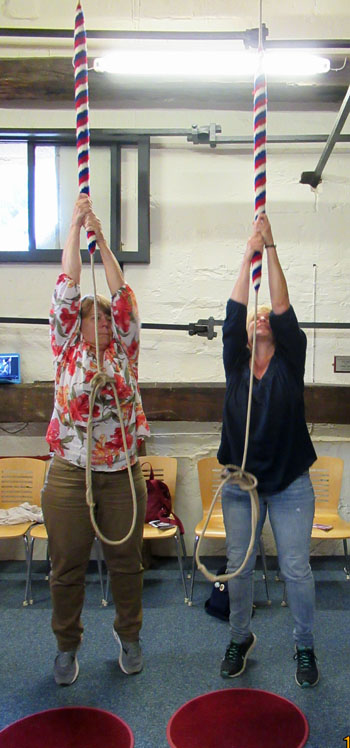 Friends Newsletter No. 93
Friends Newsletter No. 93October 2019
Friends are the recognised guardians of Malvern's water heritage (Malvern Gazette 1 March 2013 p.14). We are an independent voluntary group of Malvernologists who relentlessly promote research and celebration of Malverns Worldwide and the Springs and Wells of the Malvern Hills.
Visitors from Malverns Worldwide get the bells ringing!
One weekend in August we were delighted to host two Malvernologists from the Historical Commission in Malvern Pennsylvania. Barbara Rutz and Lynne Frederick were greeted at Great Malvern railway station by Cora and Bruce harmoniously waving a Stars and Stripes and our Union Jack. The programme of events started off with an inspection of the station, and the view of the Worm from the road bridge. Then followed a walk to the Mulberry Tree in Priory Park, with the thought that Malvern PA will ultimately decide they must have one. The medieval Priory church was next and, both ladies being very musical, couldn't believe their luck when they had the opportunity, after scaling the narrow, winding staircase and a bit of training, to ring the bells. The oldest bell they tried dates from 1346 which, in North American terms, is prehistoric!
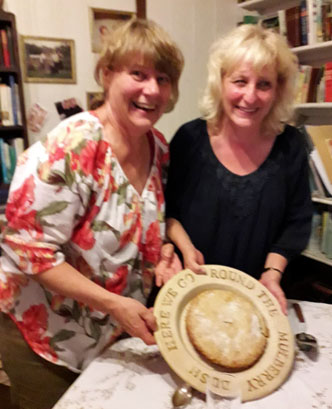
At Malvern Museum, the ladies played the Dulcetone, learned about the Water Cure and bought souvenirs. The gas lamps were also on the schedule and involved a night-time circuit of the hills taking in the Holy Well. The next day we filled bottles with Malvern Water at Hay Slad then climbed to the top of the Worcester Beacon.
Also, on the Sunday we went to the most northern reaches of the Malvern Hills District to view the footprint of the new Malverns Worldwide Lodge. Then to a traditional English summer fete in the tiny village of Eastham. The fete was held in the churchyard of the thousand-year-old local church and Barbara and Lynne enjoyed the flower and produce show, an English hot dog and meeting many local residents. Another food highlight on Saturday was dinner which included the famous Malvernberry Pie, made from mulberries encased in a pastry prepared to the special recipe secured from Malvern Iowa last year.
Lynne and Barbara have now returned to the US and Lynne has written to us: "I'll pass your greetings on to the Borough Council and Mayor this evening at their meeting." We'd much like them to come back and we've been invited to Malvern PA again. Meanwhile, we look forward to hosting more visitors from Malverns Worldwide.

Pictures: Barbara and Lynne in the thousand-year-old Malvern Priory and with Malvernberry Pie.
Malvern is a racehorse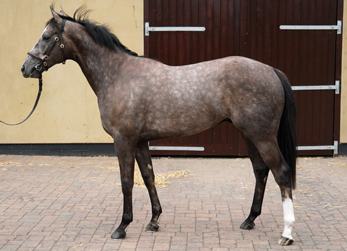
A Friend Colin from Colwall recently wrote to us raising a question about whether Malvernologists are aware that there is a racehorse called Malvern. It is a striking grey/roan two-year-old trained by Richard Hannon at Herridge near Marlborough. It made it debut to racing on the 26 July in the 6.15 race at Chepstow. It has the distinction of having around 3000 owners, each of whom will have paid about £50 for their share in the Owners Group syndicate. Jockeyed by Rossa Ryan, members of the syndicate will be pleased to learn that it won the race at Chepstow at odds of 3/1.
Malvern Holy Well before the 16th century - religious or physician cures?
What was the Malvern Holy Well like before King Henry VIII broke the Roman Catholic control of the English by destroying the monasteries circa 1530? This placed the King at the top of the hierarchy with local landowners and lords of the manor, looking to Henry for leadership. The church became a managed community force within this hierarchy. This reshuffle of power triggered scientific and economic development, ultimately leading to the Industrial Revolution which transformed communities thereafter.
Jeremy Harte, the well-known authority on Holy Wells considers the confusing question of health care for the community around this time. Health care before the dissolution of the monasteries had been in the hands of doctors (medici) for the well-off. Whether their approach would strike us as scientific or otherwise, it was thought at the time to be 'natural'. Similarly, when people linked to the Church were cured at a saint's well, this was spiritual and it was founded on the works of God and his saints. As for the less well-off, 'local sorcerers', were poor doctors who cured villagers, and don't appear in the guild lists of medici. Just because they were poor doesn't mean that they used witchcraft. Like wealthy physicians they may have had a pharmacopeia but this included marvellous cures, such as amulets, which were at the fringe of what might be considered natural. Interestingly, if patients used expensive spices and talismans of gold, you were a doctor; if you used wayside herbs and moles' feet, you were just a nobody, although the cure rate was likely the same. In addition, however a few people - magicians if they were rich, witches if they were poor - went beyond the bounds of the marvellous and started regularly using cures that had no obvious natural basis. These began to look uncomfortably like spiritual cures, because they seemed to call on powers outside this world. As a result, the Church stopped them doing it. Curing was therefore a compound mix of natural medicine, spiritual faith, sorcery and magic adjusted to suit your wealth.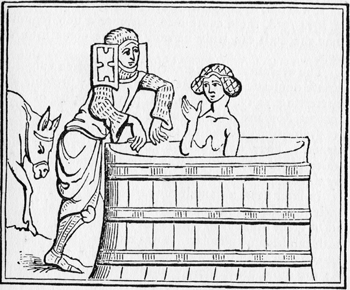
So, where did the Malvern Holy Well fit into all this? Jeremy's understanding is that sites called Holy Well were, at least for some of their history, places where people expected spiritual cures. The Church kept an eye on this, in case people were mistaken and thought they could get a miracle at some place where God would not have allowed such things. But though a miraculous spiritual cure was an option for those who were desperate or particularly devoted to their local saint, it wasn't part of ordinary medical practice. You had something wrong with you, you went to the doctor, or equivalent depending on your financial status.
Later the 'reputation of healing' at the Holy Well by the 1600s was different in kind from the sort of reputation it may have had before the dissolution. Spas were regarded by Protestants as centres of natural healing; their water had the same sort of powers as a drug or herb, not the same sort of powers as prayer. Catholics, of course, carried on going to wells for spiritual reasons and there's a whole fascinating history at sites like St. Winifred's Well where they had two different schools of thought doing the same sort of thing side by side to cure the sick and unwell.
We know that in 1558/9 the Holy Well was sold by the crown to Horneyholds. This suggests that the estate was formerly part of Little Malvern Priory and confiscated by Henry VIII at the dissolution. We also know that in the early 1600s people were visiting the Holy Well to resolve their health issues. One person is recorded as travelling from Leicestershire for the cure. Such a 140 miles round trip was quite a daunting prospect in those days. From this we can conclude that the Holy Well retained a reputation of healing that outweighed for some, the services of doctors and what was then modern medicine. This suggests that earlier, before the dissolution, the local Priory was perhaps participant in healing at the Holy Well.
Records indicate that in Great Malvern, St Werstan, a monk from Gloucestershire, came to set up a religious establishment near St Ann's Well during the time of Edward the Confessor, prior to the Norman Conquest. Subsequently a Benedictine Catholic religious order was also created at Great Malvern Priory, two miles north of the Holy Well. Similar may well have been the case with Little Malvern Priory near the Holy Well. This role was terminated by Henry VIII at the dissolution but the reputation lived on. We welcome readers participation in exploring this further and possibly by securing detailed evidence of the Holy Well prior to 1530.
Picture above - did this typify Holy Well in the 13th century? (from a contemporary manuscript)
We are much obliged to Jeremy Harte of Bourne Hall Museum, Ewell in Surrey for his participation in preparing this article.
Jacobs Fountain at the Malvern Theatres
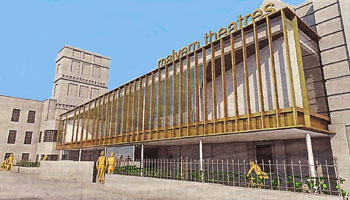 Thanks to the Malvern Gazette, we have learnt recently that the Malvern Theatres are to undergo a new refurbishment with an impressive new front facade and two storey extension facing Grange Road, Great Malvern. We will lose the historic entrance portico as a result. At the close of the 20th century the theatres were refurbished and remodelled and the Jacob Fountain which previously stood in the foyer was to be removed. After a hurried appeal to the instigators of this refurbishment, the fountain, rather than end up in a scrap dealers' yard, was reinstated in the corner of the cafeteria where it stands today, albeit minus the original plinth on which it had previously stood. Here it has enjoyed being decorated at the annual well dressing as well as being a tourist attraction.
Thanks to the Malvern Gazette, we have learnt recently that the Malvern Theatres are to undergo a new refurbishment with an impressive new front facade and two storey extension facing Grange Road, Great Malvern. We will lose the historic entrance portico as a result. At the close of the 20th century the theatres were refurbished and remodelled and the Jacob Fountain which previously stood in the foyer was to be removed. After a hurried appeal to the instigators of this refurbishment, the fountain, rather than end up in a scrap dealers' yard, was reinstated in the corner of the cafeteria where it stands today, albeit minus the original plinth on which it had previously stood. Here it has enjoyed being decorated at the annual well dressing as well as being a tourist attraction.
The question we now ask is to enquire whether this next planned remodelling of the theatres is an opportunity to reinstate the Jacob Fountain in a more central location, making it an entrance foyer feature? Let us have your views or more importantly let the Malvern Theatres have your views so that the fountain can be given the prominence that it deserves. For details of the history of this Malvern treasure go to http://www.malvernwaters.com/nationalparks.asp?search=yes&p=7&id=312 on our web site.
Malvern Hills National Park - hope for the future
The debate as to whether a National Park would aid in the protection of the Malvern Hills, the Abberley Hills and the Teme Valley continues. We therefore list 8 good reasons for this idea that has proven itself throughout the world.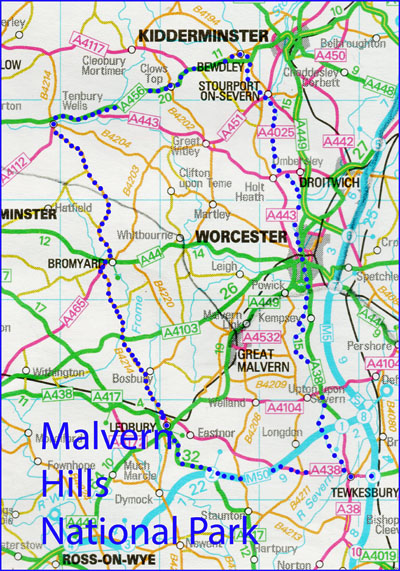
1. To curtail the relentless urbanisation of the uplands and surrounding landscape of Worcestershire.
2. A National Park offers blanket protection against inappropriate development and encompasses villages rather than fragmented selected sites.
3. It will offset the impact of industrialisation elsewhere in the West Midlands including Worcester and Droitwich.
4. It will provide a readily accessible, green, healthy, recreational breathing space for the populace of Worcestershire and the Midlands, extending that which is already established piecemeal.
5. Visitor experience is high on the agenda and therefore a National Park is an economic generator.
6. The blanket coverage coordinates many local and regional countryside initiatives under one authority.
7. It extends protection of the rural heritage that earlier generations fought hard for, including such scenic areas as the Teme Valley and Abberley Hills.
8. The location of a National Park Headquarters, Heritage and Visitor centre in Great Malvern in the future would considerably enhance the appeal of the town to tourists and as such provide a focus for related economic development in the 21st century.
Do let us have your views.
Malverns Worldwide - a Blast from the Past.
You never know what you will come across when you are researching. Here is something we discovered.
An early friendship exchange between Malverns was in 1910, when a representative from Malvern, Melbourne (Australia) visited Great Malvern. The children from Malvern Link School gave him a Union flag; he gave them an Australian flag. Gifts are exchanged every year between these and other Malverns.
In September 1951, Mrs T H McClean of Malvern, Arkansas (USA) was given a civic welcome when she visited Great Malvern. In a speech, she said that she once played the organ for President and Mrs Roosevelt when they visited her town. She did not realise that, as a child, the president had stayed in Malvern England. After lunch, Mrs McClean was taken to Priory Park to see the mulberry tree that the playwright George Bernard Shaw had planted on his 80th birthday in 1936. She ate a mulberry from the tree, 'so's to be able to tell them at home,' she said. Mrs McClean thought Great Malvern was 'prettier than our town.' She was also impressed by the number of meals we manage to have here, particularly the habit of having afternoon tea. 'I'm going right home to start that,' she said.
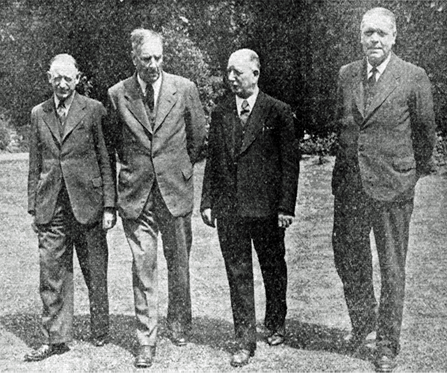
In the picture: In July 1951 Mr James Deans (2nd from the left in the photograph), Chairman of Malvern (New Zealand) Council, was welcomed by members of Malvern Urban District Council (England). Mr Deans was grandson of one of the first settlers in the Malvern Hills area, near Christchurch, New Zealand. A newspaper report stated that the Rev R Born was compiling a list of the 19 Malverns around the world.
Email: springs@thespas.co.uk (click here to send an email)
Website: Click Here
SUPPLEMENTARY INFORMATION
 Newsletter Archive which can also be accessed from our WEB SITE INDEX.
Newsletter Archive which can also be accessed from our WEB SITE INDEX.
Friendship - There is no charge made for joining Friends of Malvern Springs and Wells and Malverns Worldwide. Just let us have your email address and we will send our newsletters, which are usually two monthly. Please be aware that some email addresses block large circulation emails. Do feel free to participate in our activities by contacting us below.
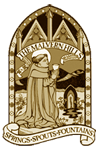
Best wishes, Cora & Bruce
Tel. 01737 213169 email bruce@thespas.co.uk
Tel. 01684 561215 email cora@malvernspa.com
1) TOPOGRAPHICAL LOCATION:
Malverns WorldwideMalvern Hills - arguably Britain's original National Park
 International Interest
International Interest3) INFORMATION CATEGORY:
History & HeritageFriends Newsletter


